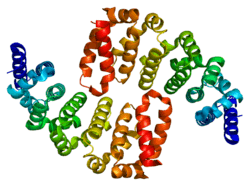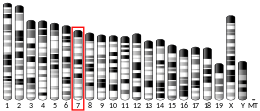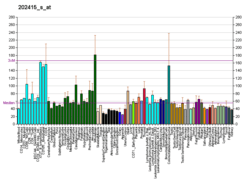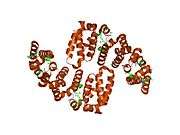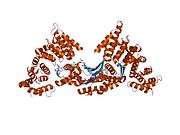HSPBP1
Hsp70-binding protein 1 is a protein that in humans is encoded by the HSPBP1 gene.[5][6][7]
References
- GRCh38: Ensembl release 89: ENSG00000133265 - Ensembl, May 2017
- GRCm38: Ensembl release 89: ENSMUSG00000063802 - Ensembl, May 2017
- "Human PubMed Reference:". National Center for Biotechnology Information, U.S. National Library of Medicine.
- "Mouse PubMed Reference:". National Center for Biotechnology Information, U.S. National Library of Medicine.
- Raynes DA, Guerriero V (Jan 2000). "Isolation and characterization of isoforms of HspBP1, inhibitors of Hsp70". Biochimica et Biophysica Acta (BBA) - Gene Structure and Expression. 1490 (1–2): 203–7. doi:10.1016/s0167-4781(99)00238-9. PMID 10786638.
- Raynes DA, Guerriero V (Dec 1998). "Inhibition of Hsp70 ATPase activity and protein renaturation by a novel Hsp70-binding protein". The Journal of Biological Chemistry. 273 (49): 32883–8. doi:10.1074/jbc.273.49.32883. PMID 9830037.
- "Entrez Gene: HSPBP1 hsp70-interacting protein".
- Rual JF, Venkatesan K, Hao T, Hirozane-Kishikawa T, Dricot A, Li N, Berriz GF, Gibbons FD, Dreze M, Ayivi-Guedehoussou N, Klitgord N, Simon C, Boxem M, Milstein S, Rosenberg J, Goldberg DS, Zhang LV, Wong SL, Franklin G, Li S, Albala JS, Lim J, Fraughton C, Llamosas E, Cevik S, Bex C, Lamesch P, Sikorski RS, Vandenhaute J, Zoghbi HY, Smolyar A, Bosak S, Sequerra R, Doucette-Stamm L, Cusick ME, Hill DE, Roth FP, Vidal M (Oct 2005). "Towards a proteome-scale map of the human protein-protein interaction network". Nature. 437 (7062): 1173–8. doi:10.1038/nature04209. PMID 16189514.
- Stelzl U, Worm U, Lalowski M, Haenig C, Brembeck FH, Goehler H, Stroedicke M, Zenkner M, Schoenherr A, Koeppen S, Timm J, Mintzlaff S, Abraham C, Bock N, Kietzmann S, Goedde A, Toksöz E, Droege A, Krobitsch S, Korn B, Birchmeier W, Lehrach H, Wanker EE (Sep 2005). "A human protein-protein interaction network: a resource for annotating the proteome". Cell. 122 (6): 957–68. doi:10.1016/j.cell.2005.08.029. hdl:11858/00-001M-0000-0010-8592-0. PMID 16169070.
- Oh WK, Song J (Aug 2003). "Cooperative interaction of Hsp40 and TPR1 with Hsp70 reverses Hsp70-HspBp1 complex formation". Molecules and Cells. 16 (1): 84–91. PMID 14503850.
Further reading
- Zou J, Guo Y, Guettouche T, Smith DF, Voellmy R (Aug 1998). "Repression of heat shock transcription factor HSF1 activation by HSP90 (HSP90 complex) that forms a stress-sensitive complex with HSF1". Cell. 94 (4): 471–80. doi:10.1016/S0092-8674(00)81588-3. PMID 9727490.
- Kabani M, McLellan C, Raynes DA, Guerriero V, Brodsky JL (Nov 2002). "HspBP1, a homologue of the yeast Fes1 and Sls1 proteins, is an Hsc70 nucleotide exchange factor". FEBS Letters. 531 (2): 339–42. doi:10.1016/S0014-5793(02)03570-6. PMID 12417338.
- McLellan CA, Raynes DA, Guerriero V (May 2003). "HspBP1, an Hsp70 cochaperone, has two structural domains and is capable of altering the conformation of the Hsp70 ATPase domain". The Journal of Biological Chemistry. 278 (21): 19017–22. doi:10.1074/jbc.M301109200. PMID 12651857.
- Oh WK, Song J (Aug 2003). "Cooperative interaction of Hsp40 and TPR1 with Hsp70 reverses Hsp70-HspBp1 complex formation". Molecules and Cells. 16 (1): 84–91. PMID 14503850.
- Lu QF, Bai M, Zhang HJ, Li JC, Xiao CF, Chen S, Wu TC (Oct 2003). "[Co-detection of P21, P53 and HSP70 and their possible role in diagnosis of polycyclic aromatic hydrocarbons (PAHs)-related lung cancer]". Zhonghua Lao Dong Wei Sheng Zhi Ye Bing Za Zhi = Zhonghua Laodong Weisheng Zhiyebing Zazhi = Chinese Journal of Industrial Hygiene and Occupational Diseases. 21 (5): 359–61. PMID 14761400.
- Alberti S, Böhse K, Arndt V, Schmitz A, Höhfeld J (Sep 2004). "The cochaperone HspBP1 inhibits the CHIP ubiquitin ligase and stimulates the maturation of the cystic fibrosis transmembrane conductance regulator". Molecular Biology of the Cell. 15 (9): 4003–10. doi:10.1091/mbc.E04-04-0293. PMC 515335. PMID 15215316.
- Shomura Y, Dragovic Z, Chang HC, Tzvetkov N, Young JC, Brodsky JL, Guerriero V, Hartl FU, Bracher A (Feb 2005). "Regulation of Hsp70 function by HspBP1: structural analysis reveals an alternate mechanism for Hsp70 nucleotide exchange". Molecular Cell. 17 (3): 367–79. doi:10.1016/j.molcel.2004.12.023. PMID 15694338.
- Stelzl U, Worm U, Lalowski M, Haenig C, Brembeck FH, Goehler H, Stroedicke M, Zenkner M, Schoenherr A, Koeppen S, Timm J, Mintzlaff S, Abraham C, Bock N, Kietzmann S, Goedde A, Toksöz E, Droege A, Krobitsch S, Korn B, Birchmeier W, Lehrach H, Wanker EE (Sep 2005). "A human protein-protein interaction network: a resource for annotating the proteome". Cell. 122 (6): 957–68. doi:10.1016/j.cell.2005.08.029. hdl:11858/00-001M-0000-0010-8592-0. PMID 16169070.
- Dai Q, Qian SB, Li HH, McDonough H, Borchers C, Huang D, Takayama S, Younger JM, Ren HY, Cyr DM, Patterson C (Nov 2005). "Regulation of the cytoplasmic quality control protein degradation pathway by BAG2". The Journal of Biological Chemistry. 280 (46): 38673–81. doi:10.1074/jbc.M507986200. PMID 16169850.
- Rual JF, Venkatesan K, Hao T, Hirozane-Kishikawa T, Dricot A, Li N, Berriz GF, Gibbons FD, Dreze M, Ayivi-Guedehoussou N, Klitgord N, Simon C, Boxem M, Milstein S, Rosenberg J, Goldberg DS, Zhang LV, Wong SL, Franklin G, Li S, Albala JS, Lim J, Fraughton C, Llamosas E, Cevik S, Bex C, Lamesch P, Sikorski RS, Vandenhaute J, Zoghbi HY, Smolyar A, Bosak S, Sequerra R, Doucette-Stamm L, Cusick ME, Hill DE, Roth FP, Vidal M (Oct 2005). "Towards a proteome-scale map of the human protein-protein interaction network". Nature. 437 (7062): 1173–8. doi:10.1038/nature04209. PMID 16189514.
- Gottwald E, Herschbach M, Lahni B, Miesfeld RL, Kunz S, Raynes DA, Guerriero V (Jun 2006). "Expression of the cochaperone HspBP1 is not coordinately regulated with Hsp70 expression". Cell Biology International. 30 (6): 553–8. doi:10.1016/j.cellbi.2006.03.005. PMID 16677834.
- Lim J, Hao T, Shaw C, Patel AJ, Szabó G, Rual JF, Fisk CJ, Li N, Smolyar A, Hill DE, Barabási AL, Vidal M, Zoghbi HY (May 2006). "A protein-protein interaction network for human inherited ataxias and disorders of Purkinje cell degeneration". Cell. 125 (4): 801–14. doi:10.1016/j.cell.2006.03.032. PMID 16713569.
- Bivik C, Rosdahl I, Ollinger K (Mar 2007). "Hsp70 protects against UVB induced apoptosis by preventing release of cathepsins and cytochrome c in human melanocytes". Carcinogenesis. 28 (3): 537–44. doi:10.1093/carcin/bgl152. PMID 16950797.
- Swayne LA, Braun JE (Mar 2007). "Aggregate-centered redistribution of proteins by mutant huntingtin". Biochemical and Biophysical Research Communications. 354 (1): 39–44. doi:10.1016/j.bbrc.2006.12.129. PMID 17208201.
This article is issued from Wikipedia. The text is licensed under Creative Commons - Attribution - Sharealike. Additional terms may apply for the media files.
